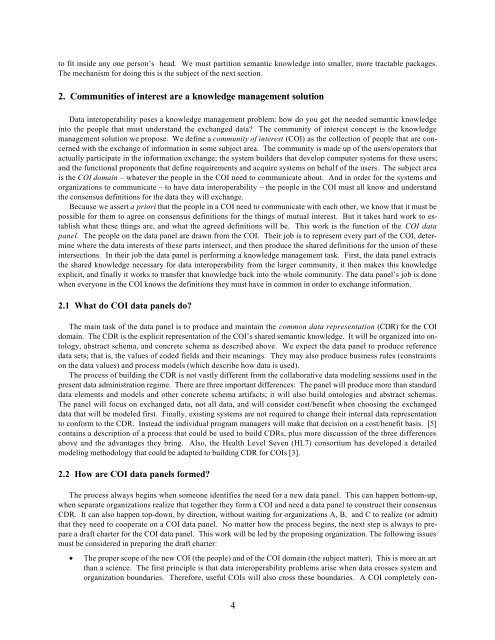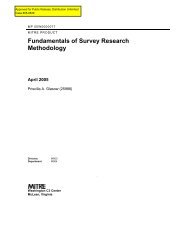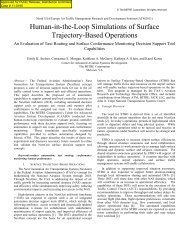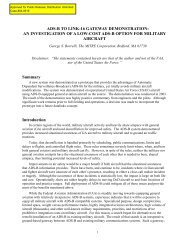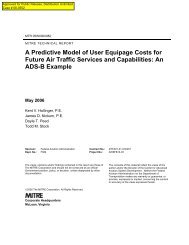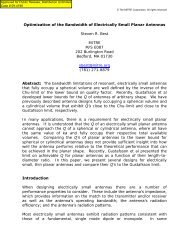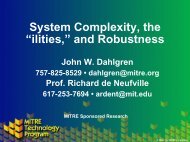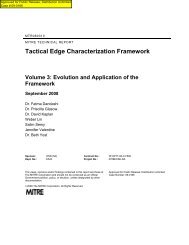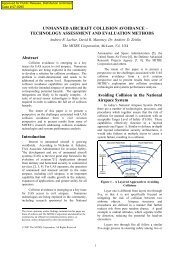A “Community of Interest” Approach to Data Interoperability - Mitre
A “Community of Interest” Approach to Data Interoperability - Mitre
A “Community of Interest” Approach to Data Interoperability - Mitre
Create successful ePaper yourself
Turn your PDF publications into a flip-book with our unique Google optimized e-Paper software.
<strong>to</strong> fit inside any one person’s head. We must partition semantic knowledge in<strong>to</strong> smaller, more tractable packages.<br />
The mechanism for doing this is the subject <strong>of</strong> the next section.<br />
2. Communities <strong>of</strong> interest are a knowledge management solution<br />
<strong>Data</strong> interoperability poses a knowledge management problem: how do you get the needed semantic knowledge<br />
in<strong>to</strong> the people that must understand the exchanged data? The community <strong>of</strong> interest concept is the knowledge<br />
management solution we propose. We define a community <strong>of</strong> interest (COI) as the collection <strong>of</strong> people that are concerned<br />
with the exchange <strong>of</strong> information in some subject area. The community is made up <strong>of</strong> the users/opera<strong>to</strong>rs that<br />
actually participate in the information exchange; the system builders that develop computer systems for these users;<br />
and the functional proponents that define requirements and acquire systems on behalf <strong>of</strong> the users. The subject area<br />
is the COI domain – whatever the people in the COI need <strong>to</strong> communicate about. And in order for the systems and<br />
organizations <strong>to</strong> communicate – <strong>to</strong> have data interoperability – the people in the COI must all know and understand<br />
the consensus definitions for the data they will exchange.<br />
Because we assert a priori that the people in a COI need <strong>to</strong> communicate with each other, we know that it must be<br />
possible for them <strong>to</strong> agree on consensus definitions for the things <strong>of</strong> mutual interest. But it takes hard work <strong>to</strong> establish<br />
what these things are, and what the agreed definitions will be. This work is the function <strong>of</strong> the COI data<br />
panel. The people on the data panel are drawn from the COI. Their job is <strong>to</strong> represent every part <strong>of</strong> the COI, determine<br />
where the data interests <strong>of</strong> these parts intersect, and then produce the shared definitions for the union <strong>of</strong> these<br />
intersections. In their job the data panel is performing a knowledge management task. First, the data panel extracts<br />
the shared knowledge necessary for data interoperability from the larger community, it then makes this knowledge<br />
explicit, and finally it works <strong>to</strong> transfer that knowledge back in<strong>to</strong> the whole community. The data panel’s job is done<br />
when everyone in the COI knows the definitions they must have in common in order <strong>to</strong> exchange information.<br />
2.1 What do COI data panels do?<br />
The main task <strong>of</strong> the data panel is <strong>to</strong> produce and maintain the common data representation (CDR) for the COI<br />
domain. The CDR is the explicit representation <strong>of</strong> the COI’s shared semantic knowledge. It will be organized in<strong>to</strong> on<strong>to</strong>logy,<br />
abstract schema, and concrete schema as described above. We expect the data panel <strong>to</strong> produce reference<br />
data sets; that is, the values <strong>of</strong> coded fields and their meanings. They may also produce business rules (constraints<br />
on the data values) and process models (which describe how data is used).<br />
The process <strong>of</strong> building the CDR is not vastly different from the collaborative data modeling sessions used in the<br />
present data administration regime. There are three important differences: The panel will produce more than standard<br />
data elements and models and other concrete schema artifacts; it will also build on<strong>to</strong>logies and abstract schemas.<br />
The panel will focus on exchanged data, not all data, and will consider cost/benefit when choosing the exchanged<br />
data that will be modeled first. Finally, existing systems are not required <strong>to</strong> change their internal data representation<br />
<strong>to</strong> conform <strong>to</strong> the CDR. Instead the individual program managers will make that decision on a cost/benefit basis. [5]<br />
contains a description <strong>of</strong> a process that could be used <strong>to</strong> build CDRs, plus more discussion <strong>of</strong> the three differences<br />
above and the advantages they bring. Also, the Health Level Seven (HL7) consortium has developed a detailed<br />
modeling methodology that could be adapted <strong>to</strong> building CDR for COIs [3].<br />
2.2 How are COI data panels formed?<br />
The process always begins when someone identifies the need for a new data panel. This can happen bot<strong>to</strong>m-up,<br />
when separate organizations realize that <strong>to</strong>gether they form a COI and need a data panel <strong>to</strong> construct their consensus<br />
CDR. It can also happen <strong>to</strong>p-down, by direction, without waiting for organizations A, B, and C <strong>to</strong> realize (or admit)<br />
that they need <strong>to</strong> cooperate on a COI data panel. No matter how the process begins, the next step is always <strong>to</strong> prepare<br />
a draft charter for the COI data panel. This work will be led by the proposing organization. The following issues<br />
must be considered in preparing the draft charter:<br />
• The proper scope <strong>of</strong> the new COI (the people) and <strong>of</strong> the COI domain (the subject matter). This is more an art<br />
than a science. The first principle is that data interoperability problems arise when data crosses system and<br />
organization boundaries. Therefore, useful COIs will also cross these boundaries. A COI completely con-<br />
4


